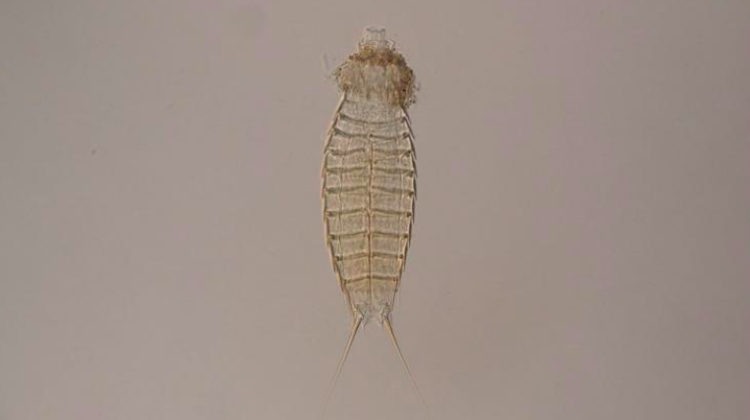Polish researcher described three new species of "mud dragons"
 Fig. Dr. Katarzyna Grzelak
Fig. Dr. Katarzyna Grzelak
Three new species of kinorhynchs, miniature dragons found in sea mud and sand of Spitsbergen, have been described by Dr. Katarzyna Grzelak from the University of Lodz. The researcher gave them names that are references to the dragons from the saga "A Song of Ice and Fire" - Echinoderes drogoni, E. rhaegali and E. daenerysae.
The researcher, who is also an assistant professor at the Institute of Oceanology PAS in Sopot, specialises in meiofauna, creatures so small that they can live between grains of sand.
It is estimated that up to 90 percent of marine species in the world are still undiscovered, waiting for a description. Large marine mammals like seals or whales, as well as birds and fish are quite well researched. But if you look at marine life on the mini or micro scale, the chances of seeing a creature that nobody has seen before are far greater, the researcher says.
Despite their small sizes, meiofauna organisms are powerful in terms of numbers. "It is estimated that up to 50,000 of these organisms can be found under one human footprint in the sand. A seemingly lifeless beach is actually a vibrant ecosystem and its biodiversity is greater than that of a coral reef, considered the most diverse ecosystem on our planet" - she adds.
Currently, out of 35 recognized phyla of animals, five belong exclusively to meiofauna, which means that the size of their bodies does not exceed 1 mm throughout the life cycle.
Of all the meiofauna representatives, Dr. Grzelak studies two groups: free-living nematodes (Nematoda) and kinorhynchs (Kinorhyncha).
According to Dr. Grzelak, nematodes are the most numerous multicellular animals currently living on Earth. Some marine sediments have nematode populations exceeding a few million individuals per square meter. Many species are commonly known parasites, but the vast majority of nematodes are free-living organisms.
The huge diversity and population size of nematodes means that they have various roles in marine sediment ecosystems. "Some feed on bacteria or algae, others are predators. By breaking down complex organic compounds into simpler compounds, they make organic matter accumulated in sediments more accessible for other +consumers+" - she explains.
Kinorhynchs are commonly known as "mud dragons". Their 11-segment body is characterized by a movable head armed with a ring of hooks and curved spines on the back. To move through the sediment, mud dragon slides his head out of the cylindrical trunk, grips the substrate with the hooks and "pulls" its body forward. After anchoring, it withdraws its head into the body and then the process repeats itself. This method of locomotion explains the etymology of the word "kinorhyncha" which means "moving snout" in Ancient Greek.
Dr. Grzelak focuses mainly on Arctic areas, where - due to logistical difficulties - meiofauna remains poorly researched.
According to the scientist, the diversity of Arctic kinorhynchs is virtually unexplored. Until recently, only 17 species belonging to this group of organisms were known (254 are described in total). Research conducted in Spitsbergen since 2016 shows that it is not only a region where mud dragons are found in extremely large numbers, but also their species diversity is definitely greater than previously thought.
The researcher recently described three newly discovered species, and the work on the next four is currently underway. This means that the diversity of Arctic kinorhynchs will soon increase by almost 40 percent.
The researcher draws inspiration for naming new species from books by George R.R. Martin. The names of the newly described kinorhynchs are references to dragons from the saga "A Song of Ice and Fire" - Drogon and Rhaegal, and Daenerys Targaryen called the "mother of dragons". They are: Echinoderes drogoni, E. rhaegali and E. daenerysae.
According to Dr. Grzelak, it is certainly not the end of surprises that hide in the sea sediments of Spitsbergen and its surroundings.
She emphasizes that it is extremely important to continue research on the Arctic meiofauna. "There are still more questions than answers concerning diversity, ecology, nutrition, population structure or reproduction of these organisms" - she notes.
Dr. Katarzyna Grzelak`s work on the diversity of nematodes and kinorhynchs in the European Arctic is part of research funded by the National Science Centre and the EU FPVII funds from the SYNTHESYS program. The researcher is a postdoctoral fellow at the University of Lodz as part of the NCUG FUGA competition, and a beneficiary of a scholarship for outstanding young scientists awarded by the Ministry of Science and Higher Education.
PAP - Science in Poland
szu/ ekr/ kap/
tr. RL
Przed dodaniem komentarza prosimy o zapoznanie z Regulaminem forum serwisu Nauka w Polsce.
















